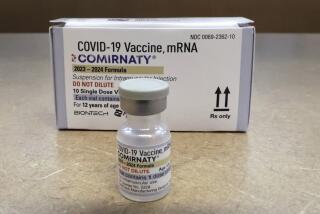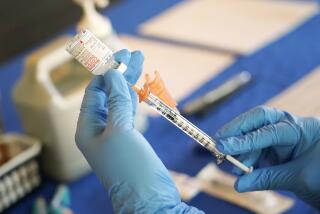Cholesterol Treatment Guide Issued : Report Could Sharply Cut Heart Attacks, Federal Panel Says
WASHINGTON — For the first time, a federal advisory panel Monday issued specific recommendations to physicians for treating people with high levels of blood cholesterol, saying that the guidelines, if followed, could prevent as many as 300,000 heart attacks every year.
“Medical practice is going to undergo a major change as a result of this report,” said Dr. DeWitt S. Goodman, professor of medicine at Columbia University in New York, chairman of the committee. “It will have a large impact on coronary heart disease and the public health.”
Lack of ‘Practical Guidance’
Although information about cholesterol-lowering therapy has been available, many physicians “were deterred” from using it because they lacked “practical guidance about how to go about it,” the panel said.
About 25% of Americans between 20 and 74 years old have high blood cholesterol, or roughly one out of four adults, the panel said, which “translates into at least 40 million people who need further evaluation or possible treatment.”
About 1.5 million Americans suffer heart attacks every year, resulting in 500,000 deaths, according to the federal government’s National Heart, Lung and Blood Institute.
The panel, which was convened by the institute, called dietary treatment the cornerstone of therapy to reduce blood cholesterol levels and said that cholesterol-lowering drugs should be used only on those with the highest risk or when diets fail. Further, the committee said, other risk factors, such as obesity, cigarette smoking, high blood pressure, being male or having a family history of premature heart disease, should be taken into consideration when determining treatment.
The panel set a single standard for measuring high cholesterol for everyone 20 or older--a change from the practice of modifying risk by age. The committee classified total blood cholesterol of 240 milligrams per deciliter of blood or above as “high blood cholesterol,” with levels of 200 to 239 considered “borderline high blood cholesterol.” Levels below 200 were classified as “desirable blood cholesterol.”
Total blood cholesterol is composed of high-density lipoprotein, or HDL cholesterol, the so-called good cholesterol, which has an inverse relationship to heart disease, and low-density lipoprotein, or LDL cholesterol, which has been implicated in the development of heart disease. LDL cholesterol “is the key index for therapy,” the panel said.
The panel recommended that all Americans over 20 have their total cholesterol measured at least once every five years and that those who are classified “borderline” have the test repeated. If they have no heart disease or other risk factors, the panel said, they should be given dietary information and retested a year later. If they do have risk factors, they should undergo more specific testing to determine their LDL cholesterol levels.
Those with total cholesterol of 240 or higher should also undergo more specific LDL cholesterol analysis, the panel said. LDL levels of 130 to 159 are classified as “borderline high-risk LDL cholesterol,” and levels of more than 160 are considered “high-risk LDL cholesterol,” the report said.
The panel said that patients with high-risk LDL levels and those with borderline high-risk LDL levels plus heart disease or two other risk factors need “intensive medical intervention” and should be given cholesterol-lowering treatment.
Dietary therapy should occur in two stages, the panel said. During the first phase, the panel said, the patient should consume no more than 30% of his total calories in fat, including no more than 10% in saturated fat and less than 300 milligrams a day in dietary cholesterol. The second phase requires further reductions of saturated fat to less than 7% of total calories and cholesterol intake to less than 200 milligrams a day.
Foods high in dietary cholesterol include egg yolks, cheeses, pork and liver. Foods high in saturated fat include butter, whole milk, cream, ice cream, cheeses, beef fat and pork fat. In addition, three plant oils--palm oil, palm kernel oil and coconut oil--are especially rich in saturated fatty acids.
The panel, acknowledging that the second stage of the dietary therapy may be difficult to follow, suggested that patients enlist the aid of a registered dietitian.
The committee urged that “maximal efforts” at dietary therapy should be made before initiating drug therapy because “drug therapy is likely to continue for many years, or for a lifetime in a given patient.”
More to Read
Sign up for Essential California
The most important California stories and recommendations in your inbox every morning.
You may occasionally receive promotional content from the Los Angeles Times.










